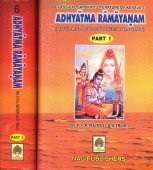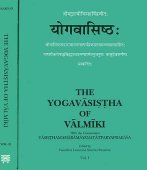Sutikshna, Sutīkṣṇa, Su-tikshna: 13 definitions
Introduction:
Sutikshna means something in Hinduism, Sanskrit, Hindi, biology. If you want to know the exact meaning, history, etymology or English translation of this term then check out the descriptions on this page. Add your comment or reference to a book if you want to contribute to this summary article.
The Sanskrit term Sutīkṣṇa can be transliterated into English as Sutiksna or Sutikshna, using the IAST transliteration scheme (?).
Alternative spellings of this word include Sutikshn.
In Hinduism
Purana and Itihasa (epic history)
Source: archive.org: Puranic EncyclopediaSutīkṣṇa (सुतीक्ष्ण).—A hermit. While Śrī Rāma and Lakṣmaṇa were living in the forest with Sītā, they visited the hermiof hermits such as Śarabhaṅga, Sutīkṣṇa and others. Once Indra came to the hermitage of Sutīkṣṇa and invited him to the world of gods. It was at this time that Śrī Rāma came to the hermitage with Sītā and Lakṣmaṇa. When they were nearing the hermitage, Indra said "I shall see Rāma later when he has completed his great task." Saying thus Indra went away from the hermitage. Śrī Rāma and his wife and brother asked the hermit, where in the forest, they were to live. The hermit told them that they could live in that hermitage itself.
This hermit was the brother and disciple of Agastya. Once Sutīkṣṇa changed a wicked and cruel man named Duṣpaṇya to a good and righteous man by sprinkling holy water of Gaṅgā on him. (See under Duṣpaṇya). (Vālmīki Rāmāyaṇa, Araṇya Kāṇḍa, Sarga 7).
Source: archive.org: Shiva Purana - English TranslationSutīkṣṇa (सुतीक्ष्ण) refers to “sharp lethal weapons”, according to the Śivapurāṇa 2.2.30. Accordingly as Brahmā narrated to Nārada:—“[...] When people were saying thus on seeing the self-immolation of Satī, her attendants rose up in anger with their weapons. [...] Consulting one another, the attendants lifted their weapons furiously and the atmosphere was pervaded with the sound of their arms. O celestial sage, some of them excessively stricken with grief cut off their limbs with their weapons, some their heads, some their faces, with the sharp lethal weapons (sutīkṣṇa) they had”.

The Purana (पुराण, purāṇas) refers to Sanskrit literature preserving ancient India’s vast cultural history, including historical legends, religious ceremonies, various arts and sciences. The eighteen mahapuranas total over 400,000 shlokas (metrical couplets) and date to at least several centuries BCE.
Biology (plants and animals)
Source: Google Books: CRC World Dictionary (Regional names)Sutikshna in India is the name of a plant defined with Moringa ovalifolia in various botanical sources. This page contains potential references in Ayurveda, modern medicine, and other folk traditions or local practices It has the synonym Moringa parvifolia Noronha (among others).
Example references for further research on medicinal uses or toxicity (see latin names for full list):
· Feddes Repertorium (1985)
· Field Museum of Natural History, Botanical Series (1902)
· Fieldiana, Botany (1946)
· Synopseos Plantarum (Persoon) (1805)
· Flora of the Southeastern United States (1903)
· Prodr. (DC.) (1825)
If you are looking for specific details regarding Sutikshna, for example diet and recipes, side effects, extract dosage, chemical composition, health benefits, pregnancy safety, have a look at these references.

This sections includes definitions from the five kingdoms of living things: Animals, Plants, Fungi, Protists and Monera. It will include both the official binomial nomenclature (scientific names usually in Latin) as well as regional spellings and variants.
Languages of India and abroad
Sanskrit dictionary
Source: DDSA: The practical Sanskrit-English dictionarySutīkṣṇa (सुतीक्ष्ण).—a.
1) very sharp.
2) very pungent.
3) acutely painful. (-kṣṇaḥ) 1 the Śigru tree.
2) Name of a sage; नाम्ना सुतीक्ष्णश्चरितेन दान्तः (nāmnā sutīkṣṇaścaritena dāntaḥ) R.13.41. °दशनः (daśanaḥ) an epithet of Śiva.
Sutīkṣṇa is a Sanskrit compound consisting of the terms su and tīkṣṇa (तीक्ष्ण).
Source: Cologne Digital Sanskrit Dictionaries: Shabda-Sagara Sanskrit-English DictionarySutīkṣṇa (सुतीक्ष्ण).—mfn.
(-kṣṇaḥ-kṣṇā-kṣṇaṃ) 1. Verp sharp. 2. Very pungent. 3. Acutely painful. m.
(-kṣṇaḥ) A tree, (Hypernathera morunga.) E. su exceedingly, and tīkṣṇa sharp, &c.
Source: Cologne Digital Sanskrit Dictionaries: Benfey Sanskrit-English DictionarySutīkṣṇa (सुतीक्ष्ण).—adj. very sharp, [Ṛtusaṃhāra] 6, 27.
Sutīkṣṇa is a Sanskrit compound consisting of the terms su and tīkṣṇa (तीक्ष्ण).
Source: Cologne Digital Sanskrit Dictionaries: Cappeller Sanskrit-English DictionarySutīkṣṇa (सुतीक्ष्ण).—[adjective] very sharp (lit. & [figuratively]); [neuter] in a high degree, very much.
Source: Cologne Digital Sanskrit Dictionaries: Monier-Williams Sanskrit-English Dictionary1) Sutīkṣṇa (सुतीक्ष्ण):—[=su-tīkṣṇa] [from su > su-tanaya] mfn. very sharp or pungent, acutely painful (am ind. ‘excessively’), [Mahābhārata; Rāmāyaṇa] etc.
2) [v.s. ...] m. Moringa Pterygosperma, [cf. Lexicographers, esp. such as amarasiṃha, halāyudha, hemacandra, etc.]
3) [v.s. ...] Name of a Muni (brother of Agastya), [Rāmāyaṇa; Bhaṭṭi-kāvya]
Source: Cologne Digital Sanskrit Dictionaries: Yates Sanskrit-English DictionarySutīkṣṇa (सुतीक्ष्ण):—[su-tīkṣṇa] (kṣṇaḥ) 1. m. A tree, Hyperanthera morunga. a. Very sharp, pungent, painful.
[Sanskrit to German]
Sanskrit, also spelled संस्कृतम् (saṃskṛtam), is an ancient language of India commonly seen as the grandmother of the Indo-European language family (even English!). Closely allied with Prakrit and Pali, Sanskrit is more exhaustive in both grammar and terms and has the most extensive collection of literature in the world, greatly surpassing its sister-languages Greek and Latin.
Hindi dictionary
Source: DDSA: A practical Hindi-English dictionarySutīkṣṇa (सुतीक्ष्ण) [Also spelled sutikshn]:—(a) very sharp/pointed; hence ~[tā] (nf).
...
Kannada-English dictionary
Source: Alar: Kannada-English corpusSutīkṣṇa (ಸುತೀಕ್ಷ್ಣ):—
1) [adjective] a very sharp; capable of cutting easily.
2) [adjective] having very sharp, keen intelligence.
--- OR ---
Sutīkṣṇa (ಸುತೀಕ್ಷ್ಣ):—[noun] (myth.) name of a hell.
Kannada is a Dravidian language (as opposed to the Indo-European language family) mainly spoken in the southwestern region of India.
Nepali dictionary
Source: unoes: Nepali-English DictionarySutīkṣṇa (सुतीक्ष्ण):—adj. 1. very sharp/pungent; 2. very subtle; 3. very painful; n. Mythol. one of the brothers of Rishi Agastya;
Nepali is the primary language of the Nepalese people counting almost 20 million native speakers. The country of Nepal is situated in the Himalaya mountain range to the north of India.
See also (Relevant definitions)
Partial matches: Tikshna, Cu, Shu.
Starts with: Sutikshnadashana, Sutikshnagra, Sutikshnaka, Sutikshnam.
Query error!
Full-text (+21): Sutikshnam, Sutikshnadashana, Sutikshn, Sutikshnagra, Citrakuta, Dushpanya, Gurushishya, Pujavidhana, Pratimadana, Sitamantra, Hairanyagarbha, Siddhantarahasya, Agastyasamhita, Granthibhedalakshana, Sarabhanga, Yamadilakshana, Pujopakaranalakshana, Dashaksharavidhi, Dashakshara, Anjaneyamanu.
Relevant text
Search found 23 books and stories containing Sutikshna, Sutīkṣṇa, Su-tikshna, Su-tīkṣṇa, Sutiksna, Su-tiksna; (plurals include: Sutikshnas, Sutīkṣṇas, tikshnas, tīkṣṇas, Sutiksnas, tiksnas). You can also click to the full overview containing English textual excerpts. Below are direct links for the most relevant articles:
Atithi or Guest Reception (study) (by Sarika. P.)
Part 1 - Virtues of Atithi-saparyā < [Chapter 10 - Virtues and Adversities]
Ramayana of Valmiki (by Hari Prasad Shastri)
Chapter 7 - The Meeting between Rama and Sutikshna < [Book 3 - Aranya-kanda]
Chapter 8 - Rama takes leave of Sutikshna < [Book 3 - Aranya-kanda]
Chapter 11 - Rama visits the different Retreats and hears of Agastya < [Book 3 - Aranya-kanda]
Skanda Purana (by G. V. Tagare)
Chapter 22 - The Greatness of Agnitīrtha: Duṣpaṇya Relieved of His Ghosthood < [Section 1 - Setu-māhātmya]
Chapter 18 - The Glory of Rāmakuṇḍa: Dharmaputra’s Atonement for False Speech < [Section 1 - Setu-māhātmya]
Chapter 39 - The Glory of Kapitīrtha: Raṃbhā and Ghṛtācī Liberated from their Curse < [Section 1 - Setu-māhātmya]
Notices of Sanskrit Manuscripts (by Rajendralala Mitra)
Page 114 < [Volume 5 (1879)]
Agni Purana (by N. Gangadharan)
Paumacariya (critical study) (by K. R. Chandra)
IV. Rama’s journey from Citrakuta to Dandakaranya < [Chapter 3 - Comparative study of the Rama-story]
5. The Basic Foundation of Paumacariya, Jaina and Popular Tradition < [Chapter 6 - Sources, contribution and influence of Paumacariyam]
Related products


